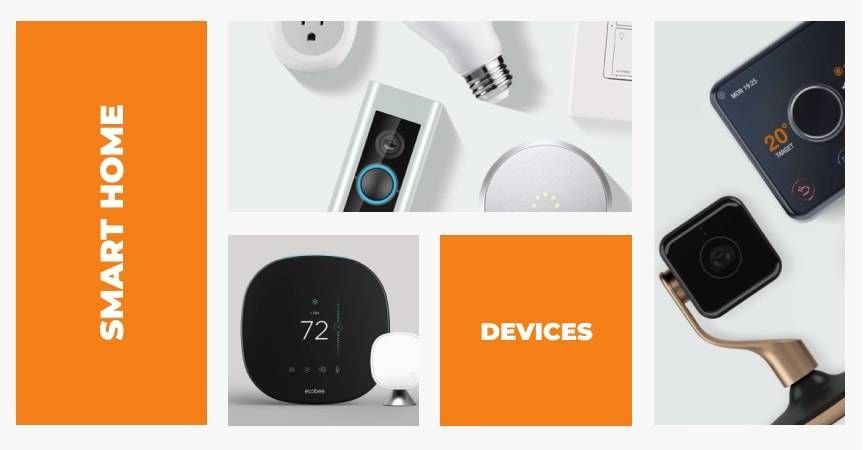

Smart home technology has become increasingly accessible and affordable, allowing more people to enjoy the benefits of home automation. Let’s learn more about this topic below with Slice Master as we explore the top budget-friendly smart home gadgets that offer great value for your money.
Smart speakers are often the first step into the world of smart home technology. These devices serve as central hubs for controlling other smart gadgets and accessing voice assistants like Alexa or Google Assistant.
The Amazon Echo Dot and Google Nest Mini are two popular budget-friendly options. Both offer excellent voice recognition, compact designs, and surprisingly good sound quality for their size and price point.
These smart speakers allow you to control other smart devices, set reminders, ask questions, play music, and even make hands-free calls. They’re an excellent starting point for anyone looking to build a smart home on a budget.
Smart plugs are among the most versatile and affordable smart home devices available. They allow you to turn any “dumb” appliance into a smart one, controllable via your smartphone or voice commands.
The TP-Link Kasa Smart Plug is a popular choice, offering reliable performance and easy setup. It works with both Alexa and Google Assistant, allowing you to integrate it seamlessly into your existing smart home setup.
With smart plugs, you can schedule your coffee maker to start brewing before you wake up, turn off forgotten appliances remotely, or create custom routines to automate your daily tasks.
Some smart plugs, like the Emporia Smart Plug, come with energy monitoring features. These allow you to track the power consumption of connected devices, helping you identify energy hogs and potentially reduce your electricity bills.
This feature is particularly useful for appliances that consume a lot of power, such as refrigerators, air conditioners, or gaming consoles. By understanding your energy usage patterns, you can make informed decisions about when to use certain appliances.
Smart lighting is another area where you can find great value for money. Smart bulbs and light strips offer convenience, energy savings, and the ability to create different moods with color and brightness adjustments.
The Wyze Bulb Color is an excellent budget-friendly option. It offers 16 million colors, dimming capabilities, and works with both Alexa and Google Assistant. You can control it via voice commands or through the Wyze app on your smartphone.
For those looking to add some ambiance, the Govee LED Light Strip is a popular choice. It’s affordable, easy to install, and offers a wide range of colors and effects that you can control via app or voice commands.
If you prefer to keep your existing bulbs, smart switches offer another way to add intelligent lighting control to your home. The Kasa Smart Light Switch by TP-Link is a budget-friendly option that’s easy to install and use.
Smart switches allow you to control your lights remotely, set schedules, and integrate them with other smart home devices. They’re particularly useful for controlling multiple lights at once or for outdoor lighting.
Home security is a crucial aspect of any smart home setup, and fortunately, there are several budget-friendly options available. These devices can provide peace of mind without breaking the bank.
The Wyze Cam v3 is an incredibly affordable smart security camera that offers impressive features for its price. It provides 1080p HD video, night vision, two-way audio, and even limited free cloud storage.
For those interested in video doorbells, the Ring Video Doorbell Wired is a cost-effective option. It offers HD video, two-way talk, and customizable motion detection, all at a fraction of the cost of premium models.
Smart door locks offer both convenience and enhanced security. The August Wi-Fi Smart Lock is a popular mid-range option that works with your existing deadbolt, making installation straightforward.
With a smart lock, you can grant temporary access to guests, lock or unlock your door remotely, and receive notifications when someone enters or leaves your home. It’s a significant upgrade to your home security system.
Smart thermostats are an investment that can pay for themselves over time through energy savings. They learn your preferences and routines, automatically adjusting your home’s temperature for optimal comfort and efficiency.
The Nest Thermostat E is a more affordable version of the popular Nest Learning Thermostat. It offers most of the same features, including remote control via smartphone, scheduling, and energy-saving suggestions.
Another budget-friendly option is the Honeywell Home T5+ Smart Thermostat. It offers geofencing capabilities, which means it can automatically adjust your home’s temperature based on your location.
Many smart thermostats can integrate with other smart home devices. For example, you can set up routines where your thermostat adjusts when your smart lock detects that you’ve left the house, helping to save energy.
Some thermostats also work with smart vents, allowing for room-by-room temperature control. While smart vents are a more significant investment, they can greatly enhance your home’s comfort and energy efficiency.
Smart sensors are relatively inexpensive devices that can significantly enhance your home’s safety and automation capabilities. There are various types of sensors available, each serving different purposes.
The Aqara Door and Window Sensor is an affordable option that can alert you when a door or window is opened. This can be useful for home security or for monitoring children’s rooms.
Motion sensors, like the Philips Hue Motion Sensor, can trigger lights to turn on when movement is detected. This is not only convenient but can also serve as a deterrent for potential intruders.
Water leak sensors, such as the Govee WiFi Water Sensor, can alert you to potential flooding, helping prevent costly water damage. These are particularly useful in areas prone to leaks, like basements or under sinks.
Temperature and humidity sensors, like the Govee Home Indoor Thermometer Hygrometer, can help you monitor conditions in different areas of your home. This is useful for maintaining optimal conditions in wine cellars, nurseries, or for monitoring pets.
While many smart home devices can work independently, a smart home hub can bring them all together, allowing for more complex automations and easier control. However, not all smart home setups require a dedicated hub.
The Samsung SmartThings Hub is a popular choice that works with a wide range of devices. It allows you to create complex routines and automations, enhancing the capabilities of your smart home system.
For those invested in the Apple ecosystem, the HomePod mini serves as both a smart speaker and a home hub for HomeKit devices. It’s more affordable than the full-sized HomePod while offering similar smart home capabilities.
If you’re comfortable with a bit of technical setup, software solutions like Home Assistant can serve as a hub for your smart home. This open-source platform runs on a variety of hardware and supports a vast array of devices.
Another option is to use IFTTT (If This Then That), a web-based service that allows you to create simple conditional statements, called applets. This can help you automate interactions between different smart home devices and services.
Creating a smart home doesn’t have to be an expensive endeavor. By choosing budget-friendly devices that offer good value for money, you can gradually build a system that enhances your home’s comfort, security, and efficiency.